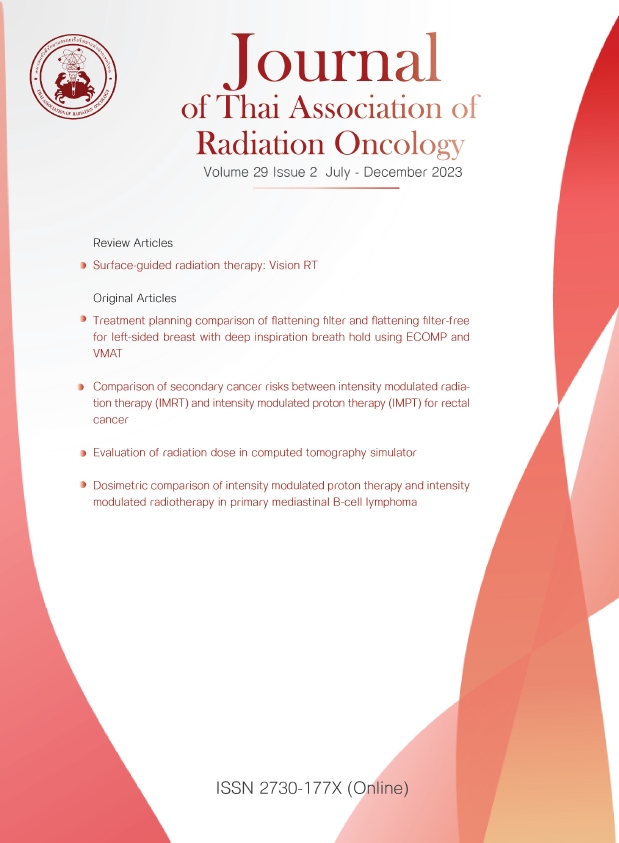Surface-guided radiation therapy: Vision RT
Keywords:
surface-guided radiation therapy, Vision RT, patient positioning, real-time monitoringAbstract
Vision RT is one type of surface-guided radiation therapy (SGRT) that Radiation Oncology division of King Chulalongkorn Memorial Hospital has used for positioning during radiotherapy session. It makes treatment more accurate by using a contact-free technique to tract the patient’s skin surface in real-time with sub-millimeter accuracy and to ensure that radiation is only delivered when the patient is in the correct position. If the patient moves out of tolerance margin, the Vision RT can automatically send signal to the treatment delivery system and pause the radiation delivery. Vision RT is considered to be safe, using infrared radiation, which is non-ionizing radiation. It is different from checking patient’s position by using image guided radiation therapy (IGRT) which uses ionizing radiation. Besides real-time checking, Vision RT can be used to check the patient’s positioning before radiotherapy for many types of cancer, such as breast cancer, brain tumor, lung cancer, liver cancer, sarcoma, head and neck cancer, etc. In addition, the using of Vision RT can be used to substitute marks or tattoos for positioning patients set up prior to treatment therapy.
References
Pan H, Cerviño LI, Pawlicki T, Jiang SB, Alksne J, Detorie N, et al. Frameless, real-time, surface imaging-guided radiosurgery: clinical outcomes for brain metastases. Neurosurgery. 2012;71:844-51
Lau SKM, Patel K, Kim T, Knipprath E, Kim GY, Cerviño LI, et al. Clinical efficacy and safety of surface imaging guided radiosurgery (SIG-RS) in the treatment of benign skull base tumors. J Neurooncol. 2017;132:307-312
Zhao B, Maquilan G, Jiang S, Schwartz DL. Minimal mask immobilization with optical surface guidance for head and neck radiotherapy. J Appl Clin Med Phys. 2018;19:17-24.
Lee SK, Huang S, Zhang L, Ballangrud AM, Aristophanous M, Cervino Arriba LI, et al. Accuracy of surface-guided patient setup for conventional radiotherapy of brain and nasopharynx cancer. J Appl Clin Med Phys. 2021;22:48-57
Mast M, Perryck S. Introduction to: Surface Guided Radiotherapy (SGRT). Tech Innov Patient Support Radiat Oncol. 2022; 22:37-38.
Olch AJ, Chlebik A, Wong K. Application of SGRT in Pediatric Patients: The CHLA Experience. In: Surface Guided Radiation Therapy. CRC Press, 2020. 351-366.
Topolnjak R, Sonke J-J , Nikamp J, Rasch C, Minkema D, Remeijer P, et al. Breast patient set up error assessment : comparison of electronic portal image devices and cone-beam computed tomography matching results. Int J Radiat Oncol Biol Phys.2010;78:1235-43.
Christoph Bert, Katherine G Methany, Karen Doppke, George T Y Chen. A phantom evaluation of a stereo-vision surface imaging system for radiotherapy patient setup. Medical Phisics.2005;32:2753-62
Sanghangthum T. Imaging in radiotherapy. J Thai Assoc of Radiat Oncol [Internet]. 2016;22:16-23.
Jursinic P, Jordan K, Chen C. Positions of radiation isocenter and the couch rotation center established by Winston-Lutz and optical measurements. Tech Innov Patient Support Radiat Oncol. 2022;21:46-50
Zhou S, Li J, Du Y, Yu S, Wang M, Wu H, et al. Development and Longitudinal Analysis of Plan-Based Streamlined Quality Assurance on Multiple Positioning Guidance Systems With Single Phantom Setup. Front Oncol. 2021;11:683733.
Covington EL, Stanley DN, Fiveash JB, Thomas EM, Marcrom SR, Bredel M, et al. Surface guided imaging during stereotactic radiosurgery with automated delivery. J Appl Clin Med Phys. 2020;21:90-95.
Kang H, Patel R, Roeske JC. Efficient quality assurance method with automated data acquisition of a single phantom setup to determine radiation and imaging isocenter congruence. J Appl Clin Med Phys. 2019;20:127-133.
Wiant D, Liu H, Hayes TL, Shang Q, Mutic S, Sintay B. Direct comparison between surface imaging and orthogonal radiographic imaging for SRS localization in phantom. J Appl Clin Med Phys. 2019;20:137-144
Tang X, Cullip T, Dooley J, Zagar T, Jones E, Chang S, et al. Dosimetric effect due to the motion during deep inspiration breath hold for left-sided breast cancer radiotherapy. J Appl Clin Med Phys. 2015;16:91-99
Rigley J, Robertson P, Scattergood L. Radiotherapy without tattoos.2020 Nov;26(4):288-293
Arphasetthasakul N, Kumkhwao J, Saksornchai K, Oonsiri P. Evaluation of cardiac and lung irradiation in left-side breast irradiation with deep inspiration breath hold technique. J Thai Assoc of Radiat Oncol. 2019;25:37-46.
Sarah C. Darby, Marianne Ewertz, Paul McGale, Anna M. Bennet, Blom-Goldman, Dorthe Brønnum, et al. Risk of ischemic heart disease in women after radiotherapy for breast cancer. N Engl J Med 2013; 368:987-998
Zagar TM, Kaidar-Person O, Tang X, Jones EE, Matney J, Das SK, et al. Utility of deep inspiration breath hold for left-sided breast radiation therapy in preventing early cardiac perfusion defects: A prospective study. Int J Radiat Oncol Biol Phys. 2017;97:903-909.
สืบค้นจาก https://www.barwonhealth.org.au/cancer-services/news/item/alcc-offers-deep-inspiration-breath-hold เมื่อ 4/8/2565
สืบค้นจาก https://www.chulacancer.net/uploads/upfiles/files/stereoT(1).pdf เมื่อ 4/8/2565
Stanley DN, McConnell KA, Kirby N, Gutiérrez AN, Papanikolaou N, Rasmussen K. Comparison of initial patient setup accuracy between surface imaging and three point localization: A retrospective analysis. J Appl Clin Med Phys. 2017;18:58-61
Mannerberg A, Kügele M, Hamid S, Edvardsson A, Petersson K, Gunnlaugsson A, et al. Faster and more accurate patient positioning with surface guided radiotherapy for ultra-hypofractionated prostate cancer patients. Tech Innov Patient Support Radiat Oncol. 2021;19:41-45.
Downloads
Published
How to Cite
Issue
Section
License
Copyright (c) 2023 Thai Association of Radiation Oncology

This work is licensed under a Creative Commons Attribution-NonCommercial-NoDerivatives 4.0 International License.
บทความที่ได้รับการตีพิมพ์เป็นลิขสิทธิ์ของวารสารมะเร็งวิวัฒน์ ข้อความที่ปรากฏในบทความแต่ละเรื่องในวารสารวิชาการเล่มนี้เป็นความคิดเห็นส่วนตัวของผู้เขียนแต่ละท่านไม่เกี่ยวข้องกับ และบุคคลากรท่านอื่น ๆ ใน สมาคมฯ แต่อย่างใด ความรับผิดชอบองค์ประกอบทั้งหมดของบทความแต่ละเรื่องเป็นของผู้เขียนแต่ละท่าน หากมีความผิดพลาดใดๆ ผู้เขียนแต่ละท่านจะรับผิดชอบบทความของตนเองแต่ผู้เดียว




